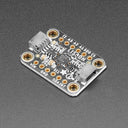Adafruit LIS3DH Triple-Axis Accelerometer (+-2g/4g/8g/16g)
by Adafruit





The LIS3DH is a very popular low power triple-axis accelerometer. It's low-cost, but has just about every 'extra' you'd want in an accelerometer:
- Three axis sensing, 10-bit precision
- ±2g/±4g/±8g/±16g selectable scaling
- Both I2C (2 possible addresses) and SPI interface options
- Interrupt output
- Multiple data rate options 1 Hz to 5Khz
- As low as 2uA current draw (just the chip itself, not including any supporting circuitry)
- Tap, Double-tap, orientation & freefall detection
- 3 additional ADC inputs you can read over I2C
To all that, Adafruit also added:
- 3.3V regulator + level shifting, so you can safely use with any Arduino or microcontroller without the need for an external level shifter!
This sensor communicates over I2C or SPI (the library code supports both) so you can share it with a bunch of other sensors on the same I2C bus. There's an address selection pin so you can have two accelerometers share an I2C bus.
To get you going fast, Adafruit spun up a custom made PCB in the STEMMA QT form factor, making them easy to interface with. The STEMMA QT connectors on either side are compatible with the SparkFun Qwiic I2C connectors. This allows you to make solderless connections between your development board and the LIS331s or to chain them with a wide range of other sensors and accessories using a compatible cable. Theyve also broken out all the pins to standard headers and added a voltage regulator and level shifting so allow you to use it with either 3.3V or 5V systems such as the Raspberry Pi + Feather series or Arduino Uno respectively.
Comes with a bit of 0.1" standard header in case you want to use it with a breadboard or perfboard. Four mounting holes for easy attachment.
Check out this tutorial for all sorts of details, including pinouts, assembly, wiring, and more!
TECHNICAL DETAILS
Revision History:
- As of August 21, 2020 we've updated this sensor to be STEMMA QT compatible - that means there's now an easy way to plug-and-play this sensor without any soldering! The physical shape and pinout has changed a little!
-
Adafruit LIS3DH Triple-Axis Accelerometer (+-2g/4g/8g/16g)
ADA2809£4.25
Shop with confidence – we've been serving the hobbyist electronics, Maker, and retro gaming communities since 2012.
- Satisfaction or refund guarantee
- Worldwide shipping via mail or courier
- 53,000+ customer reviews
- Secure website and payments